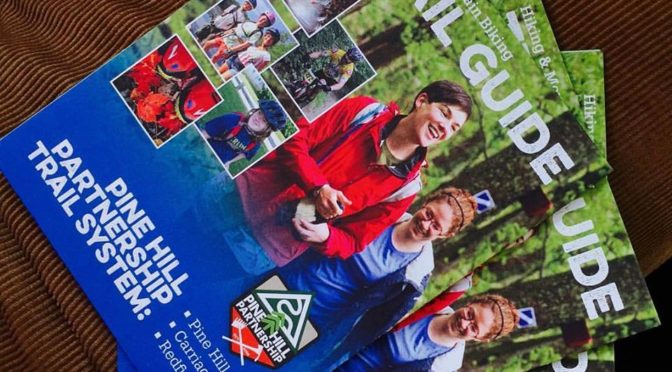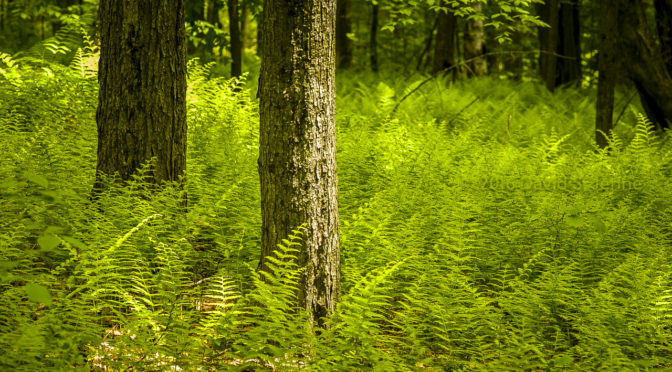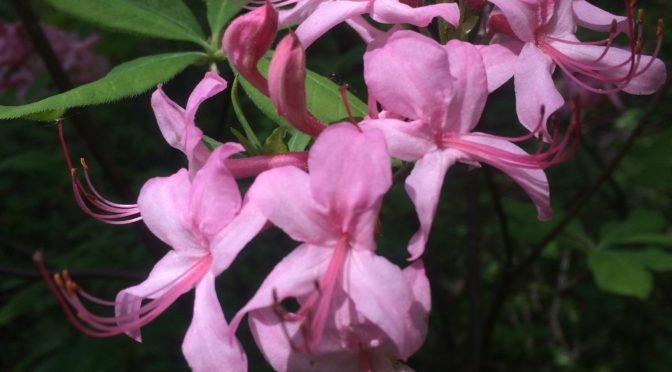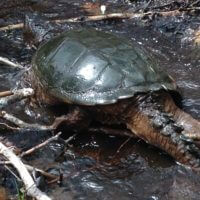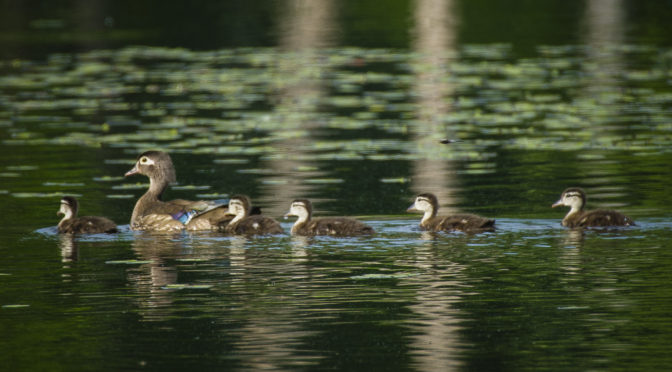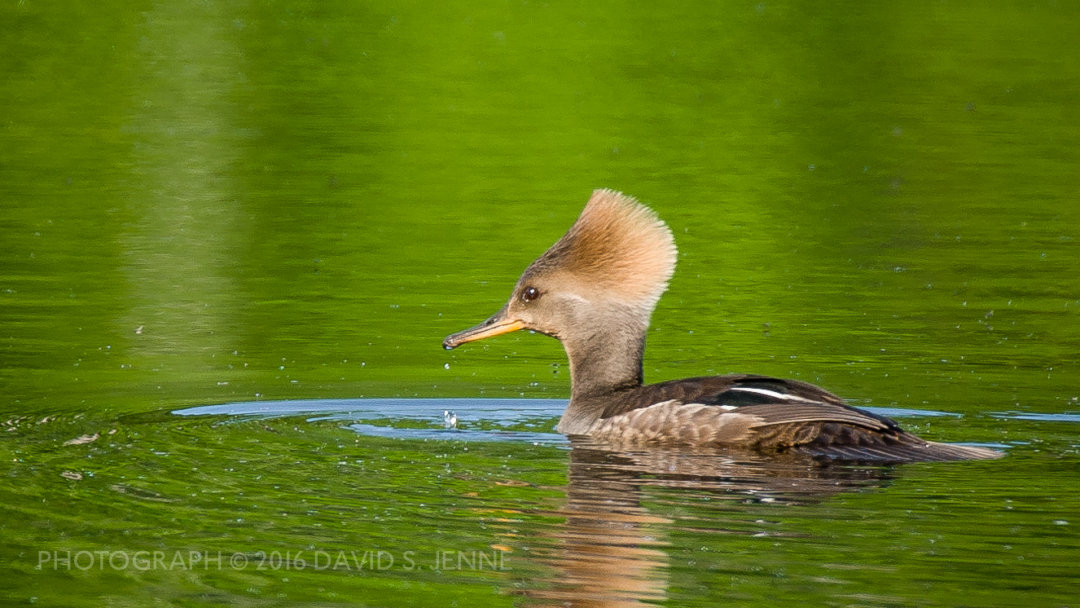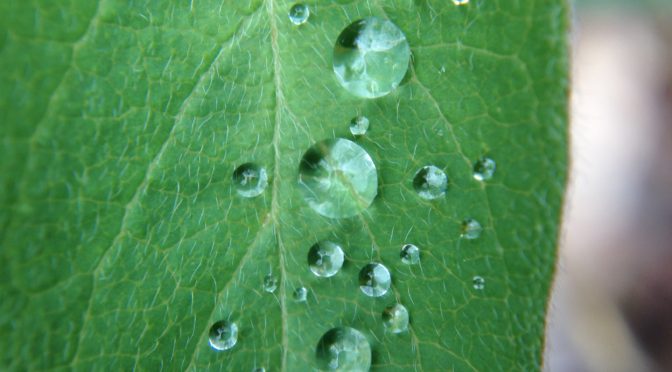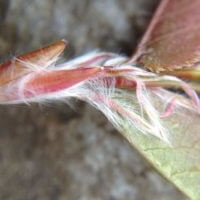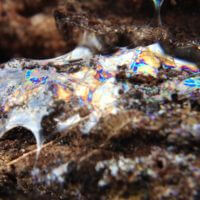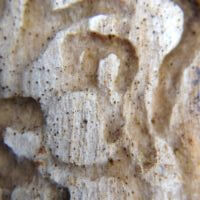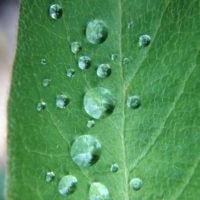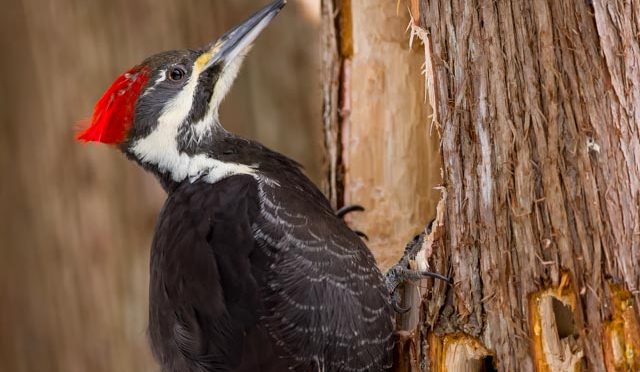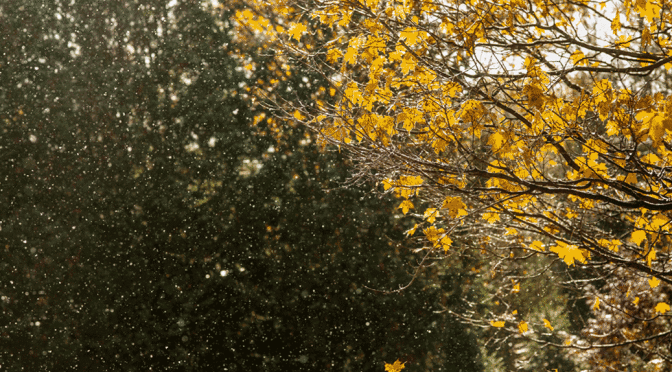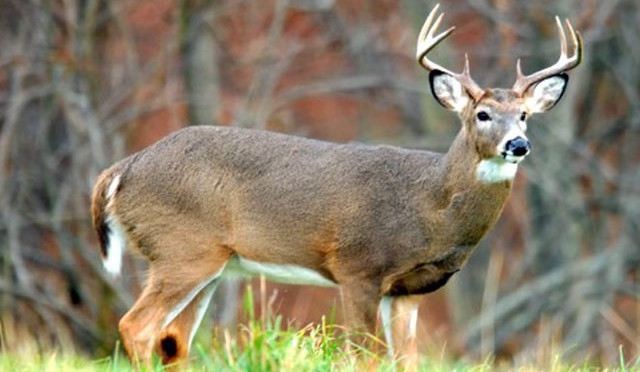Look for our new maps at the park and area businesses!
Category Archives: Observations
Hay ! That’s a Lot of Ferns.
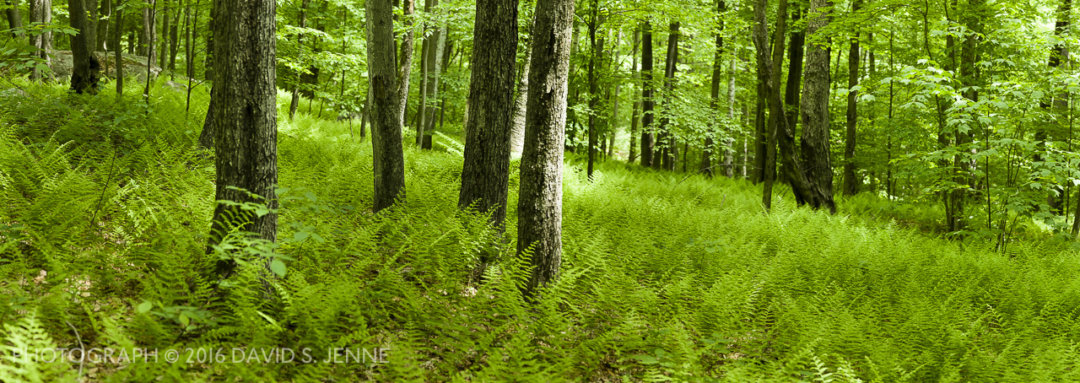
You may notice a distinct aroma of hay when you travel through certain sections of the park. That’s Hay Scented Fern (Dennstaedtia punctilobula) you’re smelling.
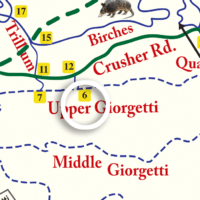 This patch is where Upper Giorgetti and Trillium intersect (Jct. 6), but my favorite spot is where Strong Angel travels under the powerline. I love to cruise downhill through that stretch in the early morning—it feels like descending on a cloud of green fluff!
This patch is where Upper Giorgetti and Trillium intersect (Jct. 6), but my favorite spot is where Strong Angel travels under the powerline. I love to cruise downhill through that stretch in the early morning—it feels like descending on a cloud of green fluff!
Here’s a link to a good guide to start you on identifying other ferns in the park if you’re interested.
Wild Times Spring 2016
By Tom Estill
Spring, 2016 Summary
The first day of spring was the first time in 3 and a half years that while hiking from Giorgetti Rink to Muddy Pond, I did not see nor hear a single bird! But, Muddy Pond itself was a different story. Paired wood ducks, mallards, Canada geese, common mergansers, and a belted kingfisher were all seen, along with painted turtles sunning themselves. Near the intersection of Carriage Trail and Redfield Farm Trail could be heard a pair of barred owls “hooting”. The last week of March was quite different with cardinals, song sparrows, northern flicker, Eastern phoebe, black-capped chickadees, white-breasted nuthatches, golden-crowned kinglets, and tufted titmouse singing, while hairy woodpeckers, yellow-bellied sapsuckers and pileated woodpeckers were drumming. Crows were harassing a young bald eagle flying over Muddy Pond, while pairs of wood ducks and Canada geese were exhibiting behaviors associated with next building on Rocky Pond. The first wildflower of the season-Coltsfoot was observed, as was a mating pair of Eastern newts.
The beginning of April saw the first appearance of robins in the park, with turkey vultures flying overhead. Countless trout lily leaves were also seen emerging from the forest floor throughout the whole park. Spring peepers were heard for the first time, and leaf buds were starting to appear on many forest trees. Snow flurries were becoming fewer in number, with only thin patches of snow appearing here and there. A pair of Canada geese were seen nesting in an isolated cove on Rocky Pond, and Bobcat tracks were seen by Shelly Lutz and Lauren White near the intersection of Stegosaurus and Redfield Trails. And this sighting happened just a few days after both of them had taken a wildlife tracking workshop. Ruffed grouse could be heard drumming in a few places in the forest. Rocky Pond water level continued to rise due to the increasing size of the beaver dam at the outlet of the Pond.
Mid-April was a time of colder temperatures and an increasing number of flurries. Frog calls decreased substantially with the declining temperatures. The hermit thrush was seen for the first time this season, Canada geese continued to sit on the nest at Rocky Pond, and Wood ducks were a common sight on Muddy Pond. Mourning doves could be heard “cooing” at Rocky Pond, and wood frogs could be heard croaking. Tadpoles were seen swimming at Rocky Pond for the first time this season. Bumblebees (there are 18 species in VT) were a common sight, along with large numbers of other small flying insects. Anglewing butterflies were seen above the old quarry along with mourning cloak butterflies. The beautiful blue iridescent tiger beetle (They have a nasty bite!) could be seen on the trails in large numbers. The spring migrating warblers were beginning to be seen with palm and yellow-rumped warblers being two of the most common. And garter snakes were seen for the first time. And, of course, with the arrival of the spring migrants, you have the arrival of their predators, especially the broad-winged hawk.
Towards the end of April, chipmunks were a common sight, yellow-bellied sapsuckers were busy building nests, red-eyed vireos were back, and trailing arbutus(flowers usually hidden by leaves) were in flower. By this time of year, fern fiddleheads are emerging, chipmunks and squirrels are a common sight, Canada mayflowers are emerging from the forest floor, and the pair of Canada geese was still on the nest at Rocky Pond. New flowers were beginning to appear on a regular basis, along with new songbirds including the rufous-sided towhee and solitary vireo. Water level at Rocky Pond continued to rise with the increasing size of the beaver dam.
The first week of May had me listening to the beautiful evening song of the hermit thrush for the first time this season, and Canada mayflowers were now becoming the dominant floor flower, replacing the declining Trout Lily. Blood root was beginning to flower. Had an early morning birdwalk on May 7th, and was surprised at how quiet the forest was. Thought I’d see and hear a lot more birds. Birds seen included: turkey vulture, cardinal, white-breasted nuthatches, yellow-bellied sapsuckers, crow, slate-colored junco, robins, American goldfinch, hairy woodpeckers, chipping sparrow, pileated woodpeckers, blue jay, tufted titmouse, black and white warbler, ovenbird, hermit thrush, Canada geese, mourning doves, wood ducks, and red-winged blackbirds. Wildflowers are starting to appear in large numbers, and new birds are starting to appear for the first time, including the black-throated blue warbler, least flycatcher and yellow-throated vireo. More and more trees are starting to “leaf out”, Lauren White saw a snapping turtle near the Rocky Pond beaver dam, and the geese at Rocky Pond mysteriously disappeared. I did receive an unconfirmed report that a pair of geese and two goslings had been seen at Rocky Pond towards the middle of May. Many wildflowers are in flower this time of year trying to beat the “leaf out” when they will be shaded, and the sunlight hitting their leaves decreases dramatically. Saw my first Red Eft walking across a trail towards the beginning of May.
In Mid-May, one could hear gray tree frogs croaking, or see Mourning Cloak, Juvenile’s or cabbage white butterflies throughout the forest, especially along the trails. Black flies were starting to become a nuisance, and I received the first of MANY reports of Osprey at both Rocky and Muddy Ponds. Light flurries were experienced as late as May 16th, the same date that I first observed flowering Jack-In-The-Pulpit flowers. Mid-May seemed to be the apex of bird activity this year. Many birds could be seen or heard on any day and still, new birds were arriving including, yellowthroat, great crested flycatcher, Eastern peewee, and scarlet tanager.
Late May saw the forest explode with wildflowers including forget-me-not (the bridge area near the trailhead is covered with them), common buttercup, false Solomon’s seal, Solomon’s seal, star flower, wild lily-of-the-valley, wild columbine, pink lady’s slipper, common cinquefoil, bunchberry, slender blue-eyed grass, and clintonia. Saw my first VERY LARGE millipede on the trail near Muddy Pond. Hadn’t realized they were found this far north. On May 29th, I saw a black water snake swim past me near the Rocky Pond beach rocks, then smelled a dead animal from an area where it swam from. Looking more closely, I found 5 dead black water snakes of varying sizes, coiled up together. I was wondering if they had recently emerged from their nearby winter den too weak to hunt after fasting over the winter months. It appears Muddy Pond had THREE successful wood duck nests this year. Broods of 8, 6, and 3 were seen by numerous people, throughout May and June. With all the dead trees lining Muddy Pond, this is no surprise to me. Holes in the dead trees make perfect nests, and the proximity to water allows for fledglings to make a quick run to the relative safety of water and nearby adults. On the last day of May I saw a pair(female and male) of Indigo Buntings near Trail Marker #11, but haven’t seen them since.
The first week of June had David Jenne emailing to Shelly Lutz (then forwarded to me), some spectacular pictures of Osprey at Muddy Pond. They’ve built a temporary nest on the top of the electric wire towers at the north end of the pond. They’ll go there to feed, but are not nesting. At least not this year. But, I’m going to make a guess that we are going to have a pair attempt to nest there next year. Maybe even take over the abandoned great blue heron nest on the East side of Muddy Pond. They’ve been a common sight at the pond, have been seen feeding there, and have been seen carrying twigs and sticks up to the temporary nest. I wait with great anticipation. Great blue herons have also been sighted at Muddy Pond, sometimes sitting on the old abandoned nest. They, too, are not nesting on the pond. The scarlet tanager is nesting somewhere around trail marker #11. While taking a group of Rutland Middle School students on a nature hike on June 7th, we were able to call in a scarlet tanager close enough for the students to get a look at one of the most beautiful birds in America.
19 more American chestnut trees were planted in Pine Hill Park this June. There are now 41 chestnut trees in the park. They are weeded, watered, sprayed (organic garlic oil) on a regular basis. For the most part, trees planted last year are doing quite well. A barred owl was seen and heard “hooting” every day for over a week towards the beginning of June just above the old rock quarry. Haven’t heard it there for a while. But, if you go up to Rocky Pond at dusk, you’re sure to hear them “hooting” on the far side of the pond, and see the beaver swimming back and forth from its dam.
By mid-June, Christmas fern spores were maturing, fireflies were seen for the first time, and new butterflies were seen including red and white admirals, and the Eastern tiger swallowtail. New flowers continue to emerge (Stay away from the Wild Parsnip at Rocky Pond), garter snakes are seen on a regular basis, male deer are just starting to grow their antlers, the cottontail rabbit is once again feeding on the Crusher trail, and bullfrogs can sometimes be heard in chorus croaking, which can be VERY loud, when dozens are croaking at the same time as commonly happens this time of year on Muddy Pond. Black flies are having a field day, with mosquitoes and deer flies trying to get their share of our blood.
That’s it for this season. Hope you’re all enjoying your time at Pine Hill Park. Please stay on the trails, and don’t hesitate to email me (testill@cksrutland.org) with any interesting wildlife sightings. I’ll be sure to put them in my next summary.
Snapping turtle
Wild Times at Big Muddy!
By Dave Jenne
I made a trip yesterday to Muddy Pond via the Park and Carriage Trail in search of some interesting photos. What a day! If you are interested in wildlife watching, stop and watch for a while at either Rocky Pond or Muddy Pond as you cross the power line on the Carriage Trail. There are some amazing critters there! Here’s a little summary of my morning (click on the images for a larger version):
I arrived at my location and was set up by 7 am (about an hour later than I wanted, but shlepping my 60+ lbs of gear up Pond Road was a good workout!) I no sooner got myself concealed and sat than the bird I had most wanted to see came to me right over the pond and carrying a large stick.
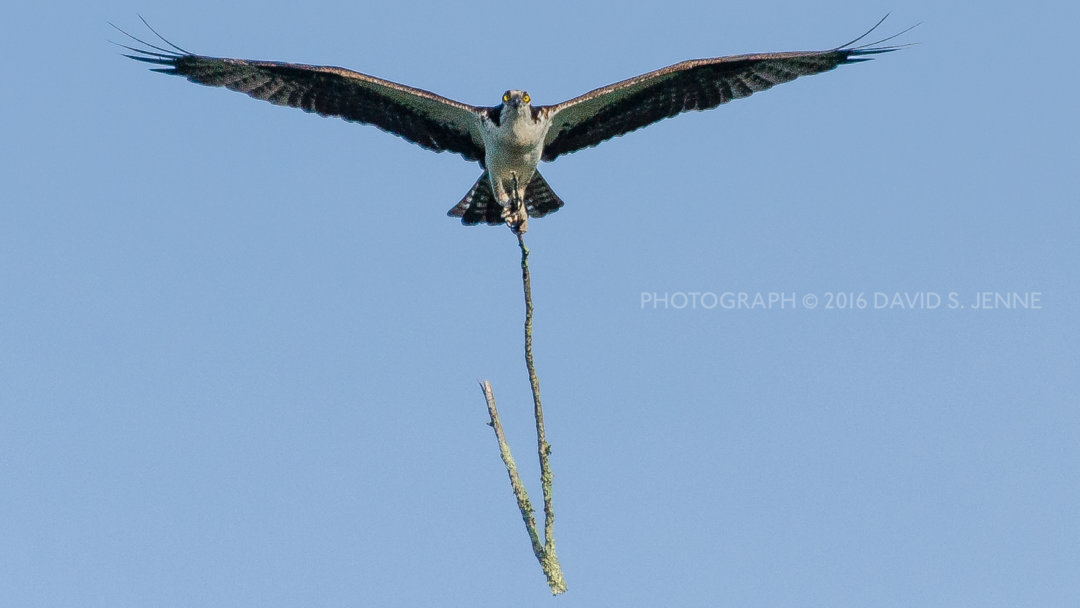
It’s possibly a young Osprey just starting to learn the skills of nest building… what he was building yesterday is best termed avant-garde sculpture!

After a couple attempts at sculpture, the Osprey glided over to the opposite side of the pond and sat in a tree for two straight hours presumably waiting for breakfast to swim under his perch.
Once my heartbeat slowed to a pace to where I could concentrate again I noticed that I had set up my blind about 10 feet away from a little dead tree snag that was being used by a Song Sparrow to announce his territory.
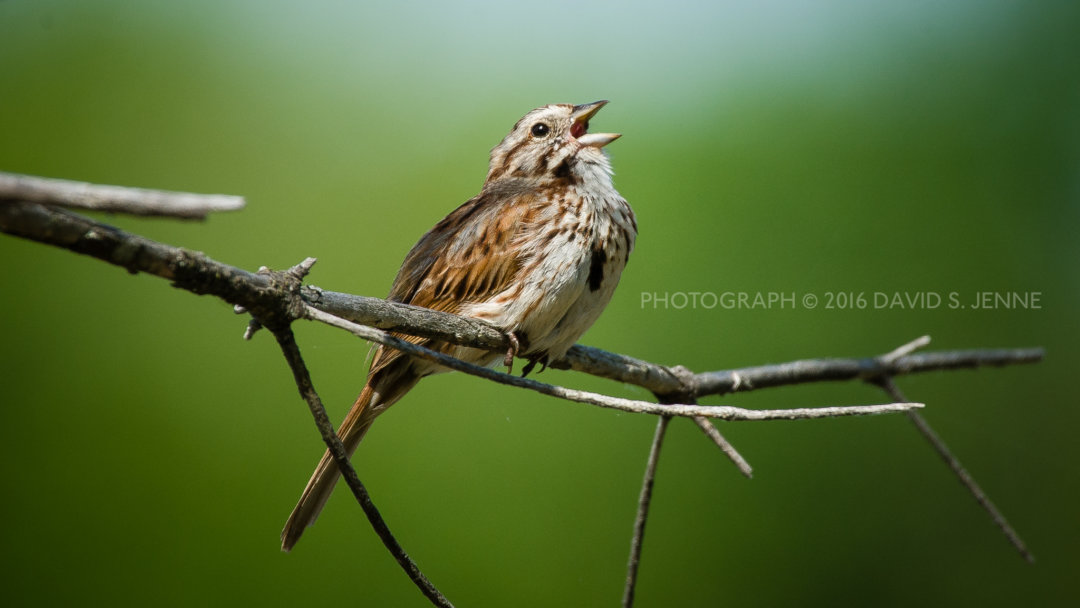
After an hour or two I discovered that this wasn’t just a territory, it was already home for a family. His mate soon dropped by with some breakfast for the nestlings which I couldn’t see from my location.
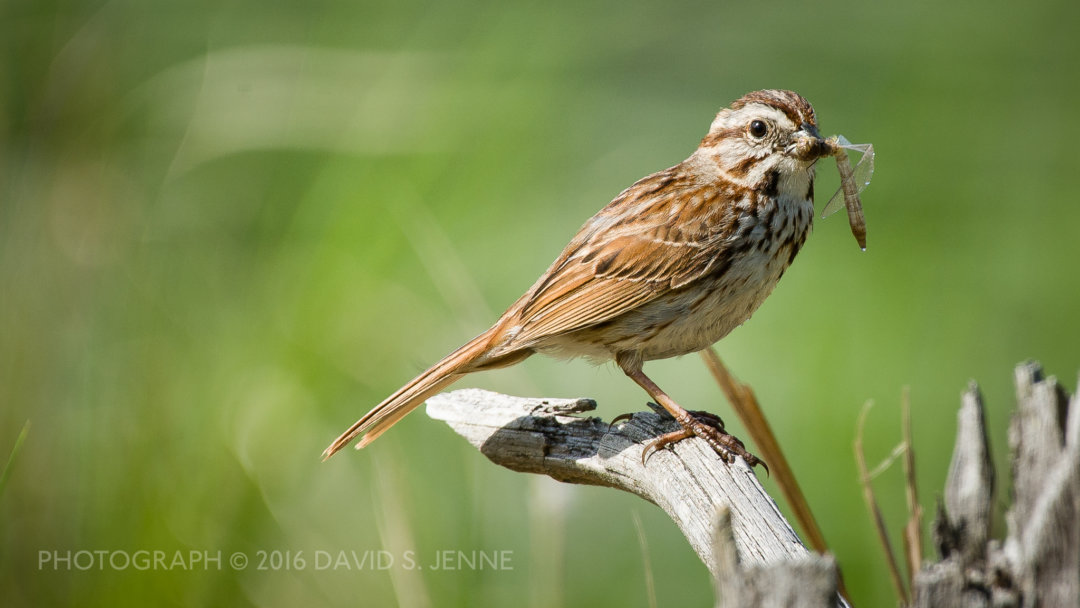
I had heard and suspected there would be some ducks with chicks at the pond and wasn’t disappointed. The first bird to swim past me was a female Hooded Merganser. There weren’t any chicks in sight, but maybe they’re still in the nest. I’ll be checking back in a week or two so maybe we’ll see some then.
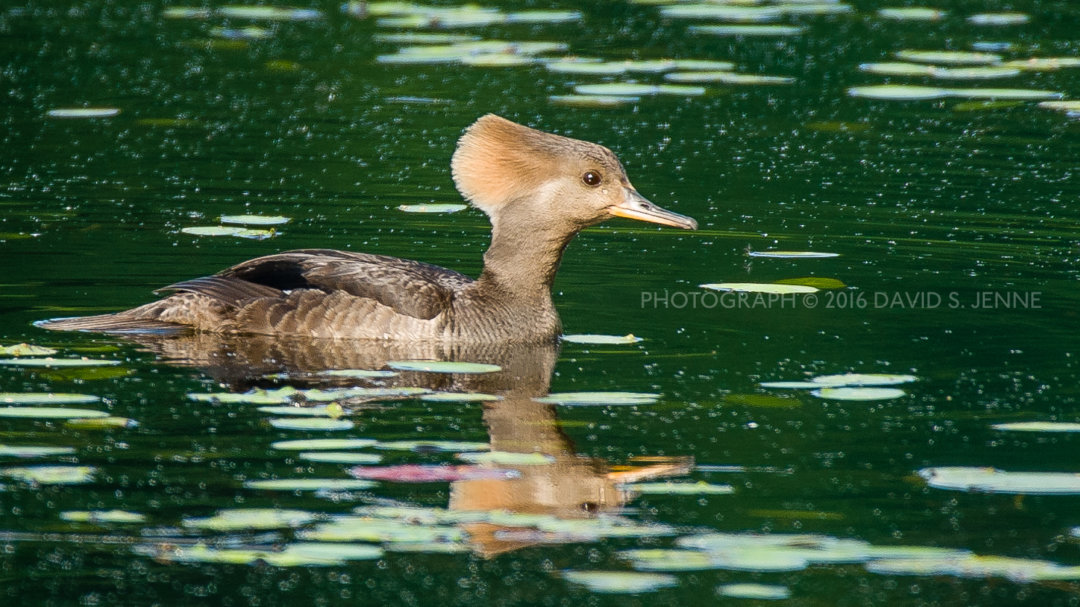
To the left of my location was another larger (30ft or so tall) dead tree. I hadn’t pointed my camera in that direction because the light was bad from that angle, but true to form, about every species of bird at the pond decided that THAT was the place to hang out! One of them was this Northern Flicker that stayed just long enough for me to get off 4 frames… and then it “Flicked” off across the pond.
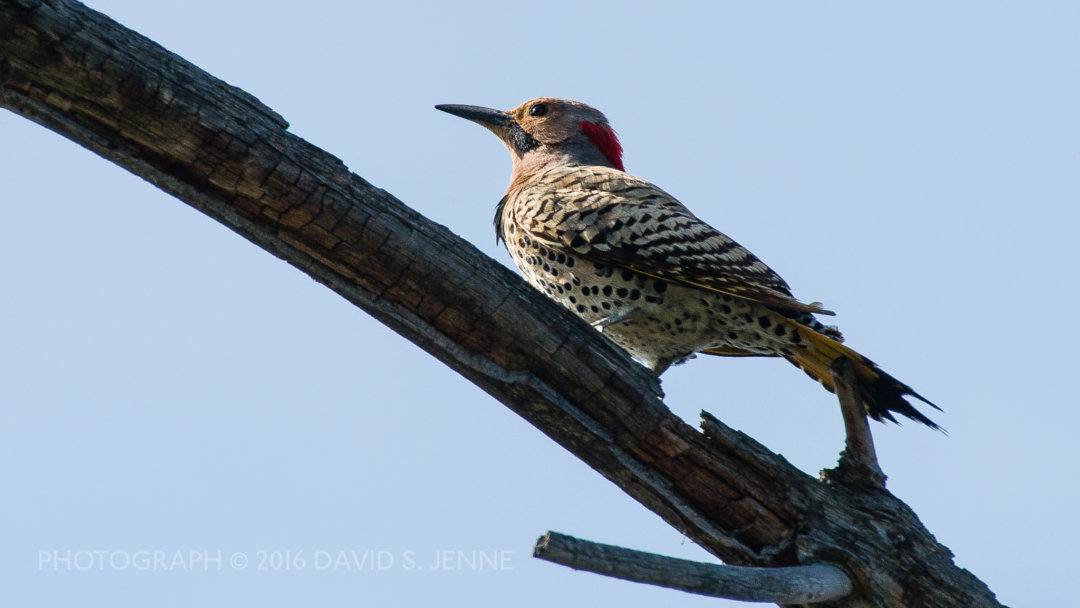
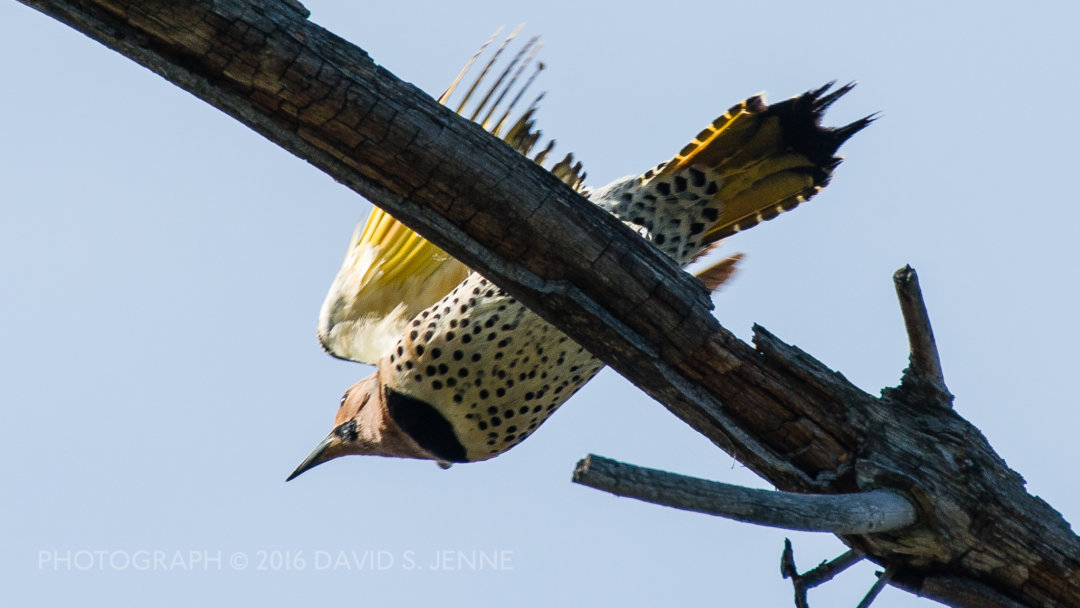
Muddy Pond is home to at least 2 broods of Wood Ducks. I counted one group with 8 ducklings and another with 5. Its always amazing to me how fast young birds can grow. Some of these guys are already looking pretty big, so probably will be just about ready to fly by the next time I see them.
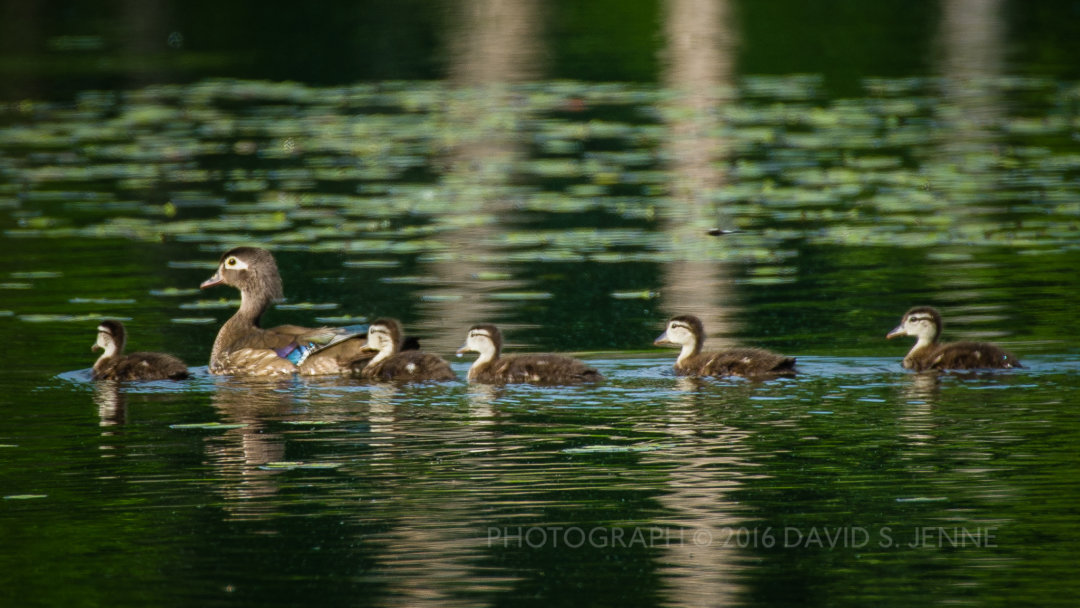
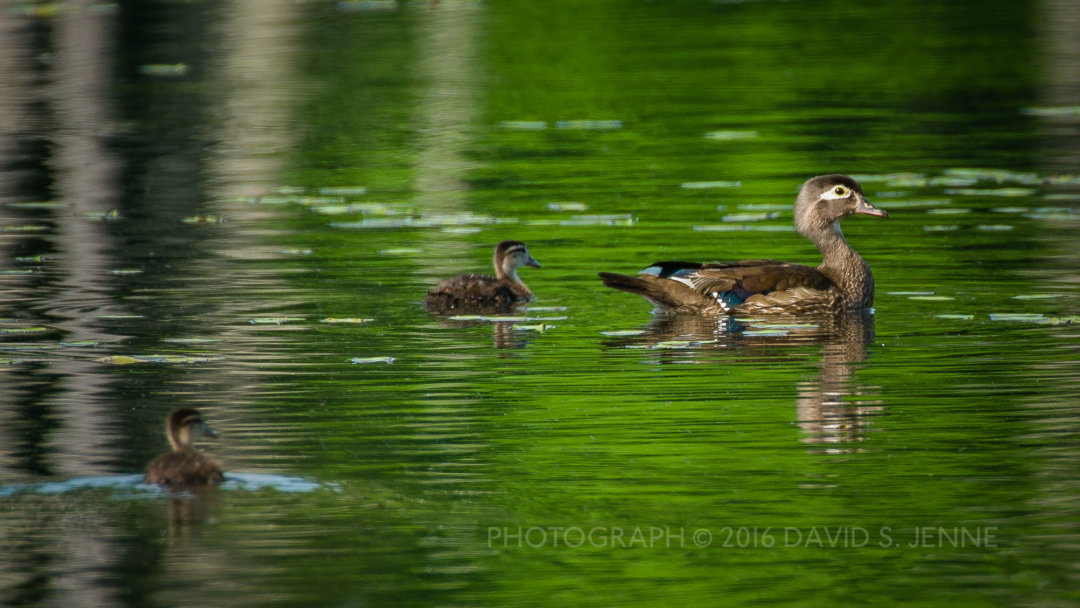
I came to the pond intending to get some photos of some of the beavers there, but there was no sign of them… although they left plenty of evidence of their presence. Be careful around the pond— especially on a windy day. Some of them are really large trees that are about ready to go!
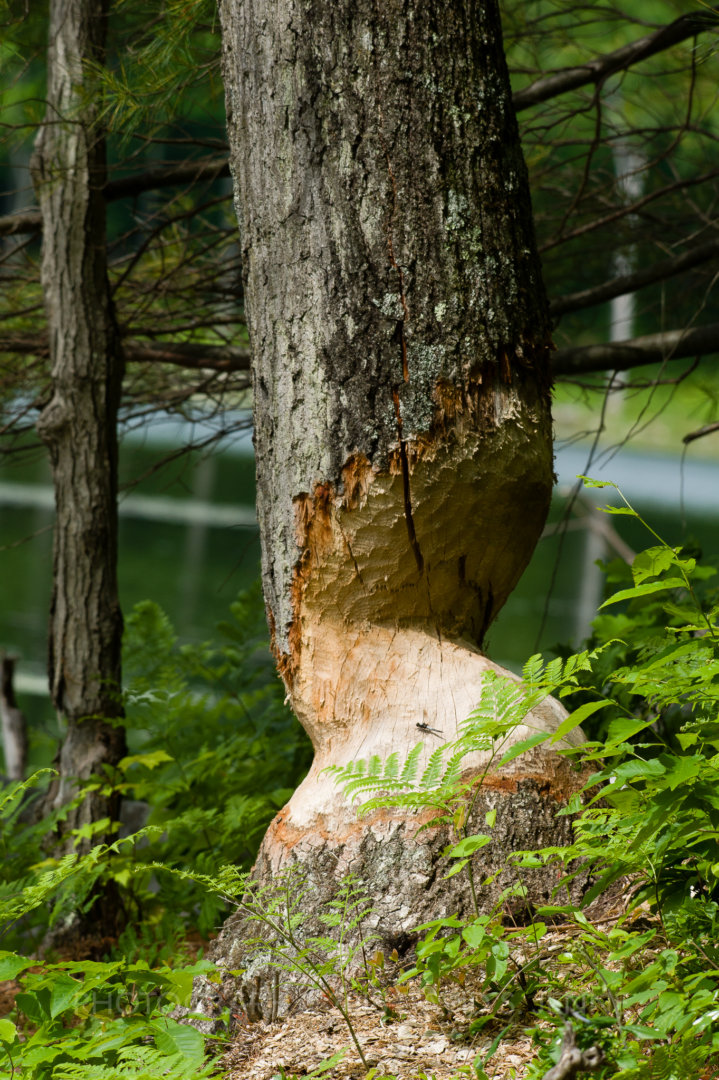
Macro Magic
Just looking at things in the park with a little different perspective.
Wild Times at Pine Hill Park
Winter 2015/16 Summary
By Tom Estill
In general, the winter of 2015/16 was relatively mild. While both Rocky and Muddy Ponds were beginning to ice over by mid-November in 2014, it wasn’t until the very end of December 2015, that the ponds were just starting to ice over. By the end of Jan. 2016, the ponds had finally completely frozen over. The first major winter storm didn’t occur until the last day of 2015.
Typical birds commonly seen towards the beginning of winter included white-breasted nuthatches, black-capped chickadees, crows and hairy woodpeckers. By the second week of Jan., only a few inches of snow covered the ground. I was surprised to see so many deer and small rodent tracks throughout the whole park. While walking along the Carriage Trail on Jan. 17th, I came across beaver tracks leading from Muddy Pond to Rocky Pond. It got me wondering? More on that later in this summary.
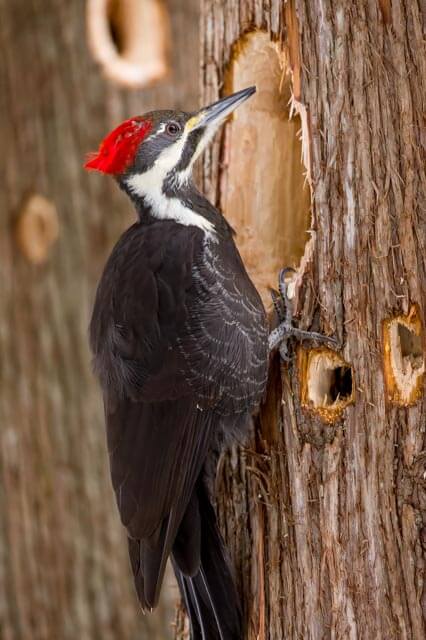
Pileated woodpeckers were heard and seen throughout the forest on a regular basis all winter long. So glad to see their population is holding strong. Only occasionally would I hear or see the tufted titmouse, and dark-eyed juncos. During the third week of Jan., I heard hairy woodpeckers “drumming” for the first time in many months, signaling a change in their territorial behavior. About the same time I followed some coyote tracks up to a small den which I know in the past was occupied by porcupines. Didn’t want to peek inside for fear of disturbing any occupants. By the end of January, warm temperatures had melted so much snow that patches of bare ground could be found throughout the whole park. On Jan. 31st, a golden-crowned kinglet landed on a branch close to where I was sitting, and a tufted titmouse could be heard singing its “peter, peter” song, another bird establishing its breeding territory. One week later, a cardinal was heard singing its territorial/courtship song, a titmouse was heard singing its “Jway” call, and a barred owl could be heard “hooting” deep in the forest west of trail marker #24.
By Feb. 6th, snow was pretty much gone from the park, except for a few isolated and sun-protected spots. Signs of recent beaver chewing activity along the shores of Rocky Pond could be seen from the Shimmer Trail. I also watched three male gray squirrels chasing a female up and down numerous trees until finally, the lead male seemed to get the attention of the female by making various calls to the female, while the other two males sat quietly on nearby branches.
Feb. 14th saw a record cold temp. for that day of -17F, with a -40F wind chill temp. recorded near midnight. While walking through the forest that day, I was amazed at the amount of cracking, snapping, and popping sounds I heard as the sap and trapped water in the trees would freeze, expand and then snap the branches and tree trunks. The second week of Feb. also found me being enchanted by the haunting rumblings emanating from beneath the ice at Rocky Pond, as the ice was shifting and moving with changes in water level, and movement of the water below the ice. Record low temperatures were once again recorded on Feb. 14, while record high temperatures were recorded two days later on 2/16. By 2/17, all signs of snow were virtually gone from the park. On 2/17, I was surprised to easily see from the Shimmer Trail a large, recently built, active beaver den on the West side of Rocky Pond. That explained the beaver footprints leading to Rocky Pond from Muddy Pond I had seen weeks earlier, and all the recent beaver chewing activity seen along the shores of Rocky Pond. Many tree branches were seen poking out of the ice near the den where the beaver had been storing food for the winter months.
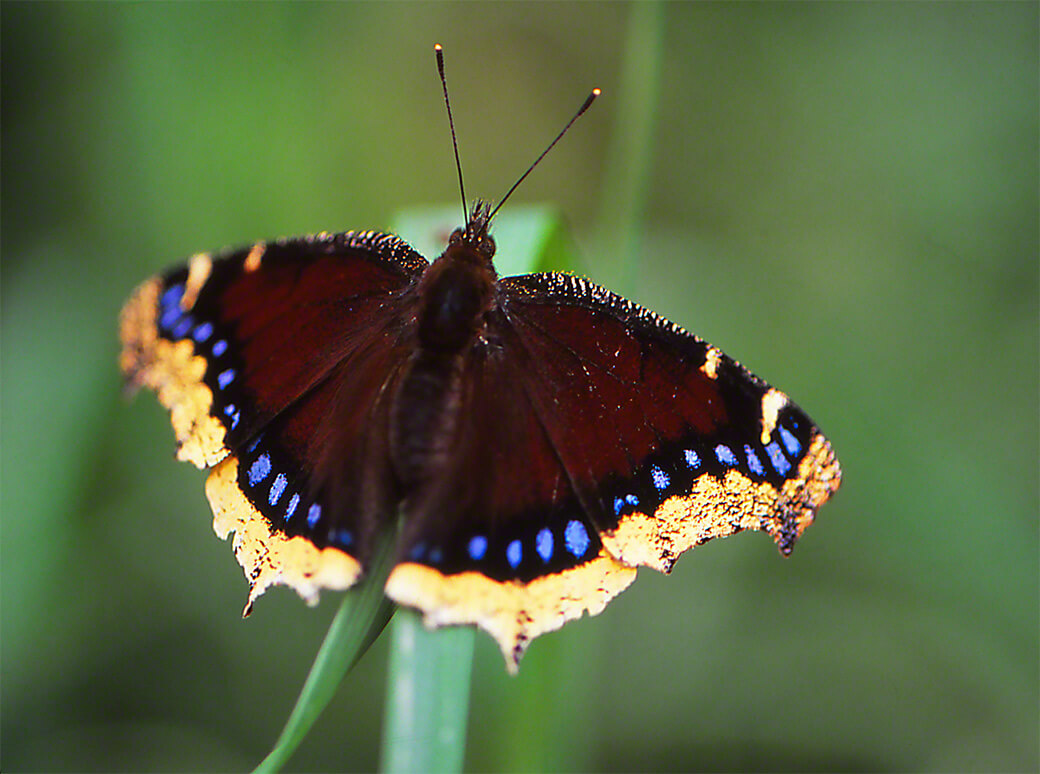
First robin was seen at the park on Feb. 20th. And a week later, I received a report of a bald eagle flying near the power lines on the Carriage Trail near Rocky Pond. During the first week of March, mourning doves were heard “cooing” near the trailhead, streams were running ice free, a large beaver was seen for the first time feeding on a downed tree at Rocky Pond, and chipmunks were seen scurrying among the downed trees along the middle Giorgetti Trail. March 13th saw the first butterfly of the season, a Mourning Cloak, one of the first butterflies to emerge from their winter hibernation under the bark of trees, and the first Eastern Newts swimming in large numbers along the shores of Rocky Pond. Both ponds were free of any ice, and moss plants were beginning to grow reproductive stalks. During Feb. and March, I had noticed the water level of Rocky Pond slowing creeping upwards so was not surprised when, walking along the Carriage Trail; I saw a new beaver dam being built at the outlet of Rocky Pond. I’ve been wondering just how big that dam will become in the future?
By mid-March, Canada geese, common mergansers, mallards, wood ducks and kingfishers could be easily seen from the Carriage Trail on Muddy Pond. The last day of winter, I went on a hike through the forest and for the first time in three and a half years, I didn’t see or hear a single bird in the forest, but I did see painted turtle sunning themselves at Rocky Pond, and received a report of a pair of barred owls seen near the intersection of the Carriage Trail and the Redfield Farm trail.
The forest is still relatively quiet, and I wait with great anticipation for the arrival of our spring migrant birds, and the first spring wildflowers.
As a reminder, please respect the No Trespassing/Private Property signs and stay on the trails. Now, go enjoy the arrival of spring at Pine Hill Park.
Night hike for night critters
Join local naturalist Tom Estill on a night stroll along the Carriage Trail as we search for the “night critters” of Pine Hill Park. We’ll especially be listening to the call of owls, foxes, coyotes, and frogs, and observing the night work of beavers at Rocky Pond. Wear comfortable shoes and dress for the weather. Bring along water, a small snack and a flashlight, also.
Difficulty: Easy to Moderate Walk
Ages 11+ – Giorgetti Pine Hill Park
April 16th, 7-9pm
Nature Of the Park – Fall 2015
Thank you to Tom Estill who is doing the live reporting from Pine Hill Park and surrounding trails.
Pine Hill Park Fall, 2015 • Natural History Summary
The first official day of fall, 2015 saw a cold front move through the area bringing with it the first noticeably cool weather since spring and beautiful dark blue skies. During an evening walk on 9/21, crickets could be heard, and many birds were seen including blue jays, robins, black-capped chickadees, white-breasted nuthatches, slate-colored juncos, and pileated and hairy woodpeckers. Warblers were migrating through the forest, the most impressive to me being the black-throated blue warbler. Small flocks of migrating waterfowl could be seen at Muddy Pond including mallards and Canada geese.
At the end of Sept. I saw a yellow-bellied sapsucker flying from its perch catching insects passing by, a behavior I hadn’t seen before in sapsuckers. Though grey squirrels and chipmunks are commonly seen in the park, I was surprised to see a red squirrel near Muddy Pond. They’re not near as common as the grey squirrel.
It was this time of year that I also saw my first loose association of birds. Birds of different species associate with one another during the harsh winter season for protection and help in obtaining food. An association of brown creepers, tufted titmouse, hairy woodpeckers, white-breasted nuthatches, pine warbler, and black-capped chickadees was seen slowly flying through the forest together. In other parts of the forest were seen blue jays, white-throated sparrows, catbirds, many flying insects and butterflies, including mating half-banded tapers.
Only a few flowers remained including New England Aster, Queen Anne’s Lace, goldenrod, and blue wood aster. All of which were being pollinated by bumble bees, yellow jackets, and bald-faced hornets.
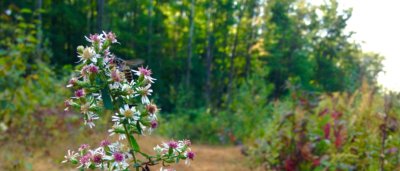
By the end of Sept., Muddy Pond now had a few hundred Canada Geese resting there, along with a few wood ducks, mallards, and a great blue heron. Also at Muddy Pond could be seen painted turtles, hermit thrushes, American goldfinches, and a belted kingfisher. The well known Wooly Bear caterpillar was also seen for the first time.
The first week of October found the forest very quiet. Asters were about the only flowers left to be found and milkweed seed pods were getting ready to open to release their hundreds of seeds. Birds typically found in winter were now the most common birds seen including blue jays, black-capped chickadees, white-breasted nuthatches, crows, and hairy woodpeckders. Hermit thrushes and American redstarts were almost gone, but the population of Canada Geese at Muddy Pond has increased to around 300. A winter wren and yellow-rumped warbler were also seen.
Oct. 10th brought cool temperatures and a gorgeous fall day. Fall foliage was at, or near, its maximum. Warblers continued to migrate through the area, with pine warblers, yellow-rumped warblers and golden-crowned kinglets being the most commonly seen migrants. For the first time, I saw a solitary OTTER feeding on a fish at Muddy Pond. Haven’t seen it again since then. Lots of grey squirrels and chipmunks continue to be seen.
On Oct. 12th, I experienced a most enchanting phenomenon. Fall foliage was at its maximum. As the sun was setting, its light was filtering through the colored leaves, and bathed the woods in a most pleasant light. A truly beautiful, magical, and serene experience. A pileated woodpecker was the only bird I saw in the forest that day, along with one grey squirrel, but lots of chipmunks. So many chipmunks were seen this year, that I was wondering if maybe they were at the apex of their population growth cycle, and maybe we’ll see a decline in their numbers in the next few years, along with a corresponding increase in the number of predators. Also on this day, I observed an interesting behavior of the Canada Geese at Muddy Pond. As I was watching the geese, a period of relative quietness would be interrupted by a dramatic increase in “chatter” among the geese, followed by a flock of geese flying off in a southerly direction. This happened over and over again. Don’t want to get anthropomorphic here, but I had the feeling that the geese were saying goodbye to some of their fellow geese before they took off to continue their trip south.
The first light precipitation of freezing rain occurred on Oct. 17th. The only plant in flower was witch hazel, giving the forest areas of easily visible yellow. With the relatively dry August and Sept., I was sure the fall foliage season would suffer, but that was not the case. We had an absolutely beautiful fall foliage season this year.
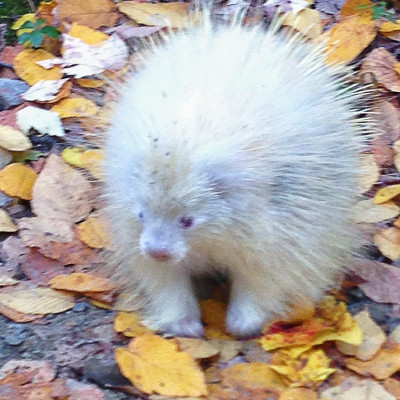
On the third week of Oct., I received an email from our Parks and Rec. Director Cindi Wight. She forwarded an email she had received from Jen Hogan. Jen had come across an ALBINO porcupine on one of the trails and sent a picture of the rare animal to Cindi. I can’t begin to tell you how excited I was to see that picture. But as hard as I’ve tried to find that porcupine, I haven’t been able to find it for the last 2 months. As soon as we get some appreciable snowfall I’m hoping to find some tracks of the porcupine and follow it to its den.
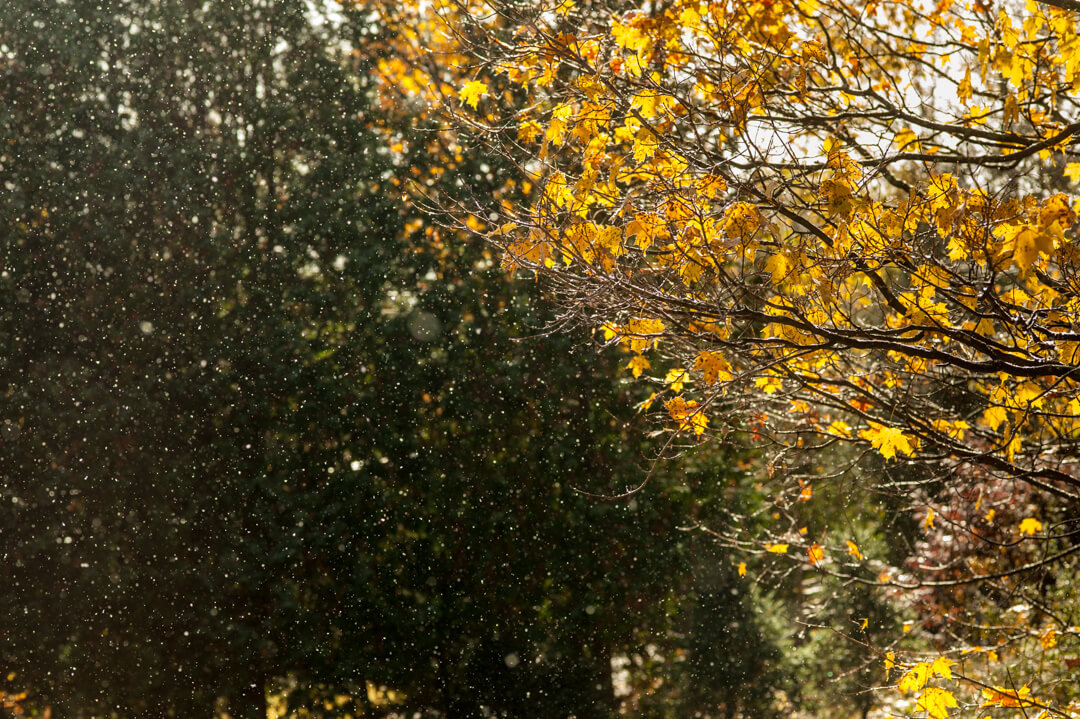
On Oct. 20th, I was surprised to see flocks of migrating yellow-rumped warblers flying through the forest, and a very plump, healthy looking garter snake. Swarms of unidentified small brown insects found along a number of trails, also.(No, they weren’t ants). Had two different pairs of pileated woodpeckers fly within a few feet of me after calling them in with my bird caller. Tiny white-colored insects, called wooly aphids were seen in large numbers today.
During the last week of Oct., I was surprised to see a yellow throat bird, and the shoreline of Muddy Pond covered in Goose feathers and down, so much so that it looked like the shorline was covered in snow. Loose bird associations are a common sight, and so are flocks of migrating robins. Turkeys heard under the powerlines on the Carriage Trail. The only ferns with green leaves left in the park are Christmas ferns, spinulosa and marginal wood ferns and rock polypody. Most leaves are off the trees with the exception of oak and beech trees. Ruffed grouse seen at Rocky Pond. Hermit thrushes seen migrating through the forest to my surprise.
The first week of November had Jen Hogan showing me where she saw the albino porcupine, but again, we had no luck in seeing the animal. Temperatures that week reached 65 degrees F. The second week of Nov., I received a second report of a sighting of an albino porcupine. Some hikers seen in SHORTS!! This was the week most of the oaks trees finally dropped their leaves, leaving the forest floor covered with a thick layer of oak leaves.
By Nov. 15th, temperatures were finally low enough for ice to cover my birdbath, but Rocky and Muddy Ponds were still ice free. The ponds were completely frozen over for the first time on Nov. 16th of last year. A migrating red-tailed hawk was seen this week, along with a few loose bird associations, so common this time of year. I was also surprised to find a Tamarack tree on droopy muffin trail between trail markers #22 and #22A. They’re usually found in more moist environments. I haven’t seen any tamaracks around rocky or muddy ponds. The tamarack was easy to see in the forest with its bright yellow leaves. Muddy Pond was covered with so many Canada geese, I couldn’t count them.
The last week of Nov. found Rocky Pond with a few shoreline areas iced over, with Muddy Pond almost completely iced over. The number of Canada geese at Muddy Pond had dramatically decreased. For the first time, I also noticed a marked increase in the number of trees being chewed on by beavers at Rocky Pond. I believe beaver are beginning to build a den on the East side of the pond. As strange as it seems, Nov. 27th saw hikers in shorts once again, but by Nov. 29th, cold temperatures had returned. Temperatures had climbed so high, that both ponds were once again open water.
The first week of Dec. found Muddy Pond covered with hundreds of Canada geese as I watch flock after flock, after flock fly into the pond one afternoon. Most of the pond was frozen over, and Rocky Pond was completely frozen over with a thin sheet of ice.
By Dec. 12th, hikers were once again in their shorts, and both ponds were free of any ice.
On Dec. 19th, I took my last hike of the season. Though there was a dusting of snow on the ground, both ponds were still free of ice, there were about 100 Canada geese at Muddy Pond, and the forest was very quiet with me seeing only crows, and white-breasted nuthatches. Two deer seen near the ledges.
See Related:
It’s Deer Season
Deer season is here. Youth weekend is Saturday and Sunday, November 7th and 8th.
Rifle Season starts Saturday, November 14th and runs through Sunday, November 29th.
Muzzle loading season starts Saturday, December 5th and runs through Sunday, December 13th.
There is NO HUNTING allowed in Pine Hill Park.
Hunting is allowed on the Redfield trails and the Carriage Trail. Please wear blaze orange if you are going to ride these trails.

